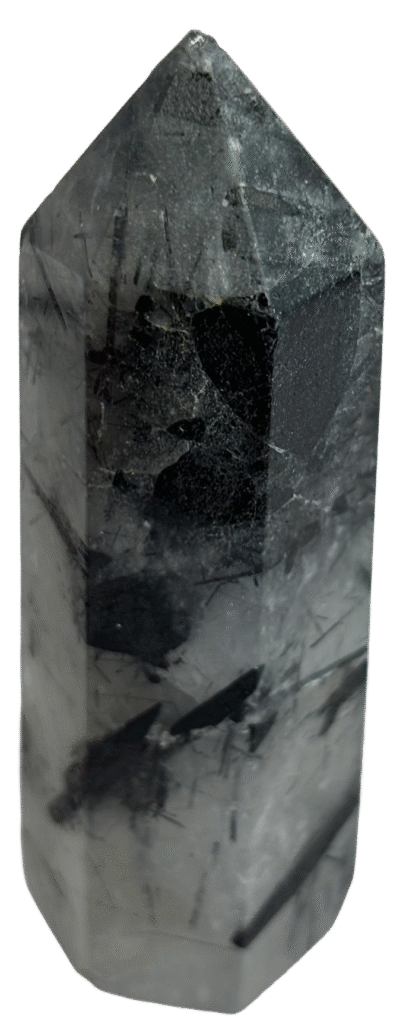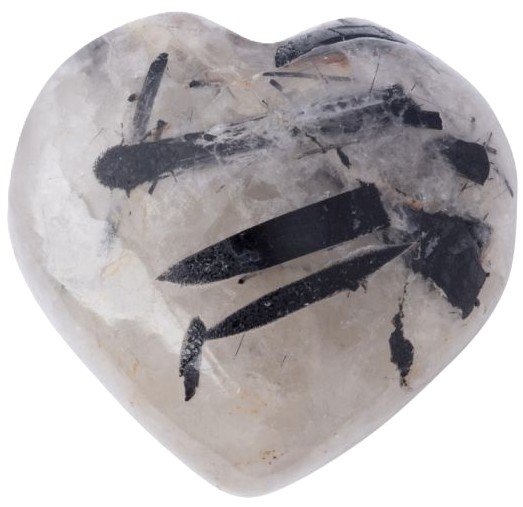
Tourmaline in Quartz, a stunning gemstone combination, embodies the powerful synergy between two of nature’s most admired minerals. The striking black or coloured strands of tourmaline encapsulated within the clarity of quartz create a visually captivating and energetically potent stone. Revered for its aesthetic appeal and spiritual properties, this gemstone has become a staple in jewellery, decoration, and holistic practices. This article provides a deep dive into its origins, characteristics, and significance.
Origins of Its Name and Alternate Names
The term “Tourmaline in Quartz” refers to the combination of black or coloured tourmaline inclusions embedded within clear or milky quartz. The name “Tourmaline” is derived from the Sinhalese word toramalli, meaning “mixed gems,” due to its variety of colours.
This gemstone is sometimes referred to as “Tourmalinated Quartz,” “Black Needle Quartz,” or “Rutilated Black Quartz,” though the latter is technically incorrect as rutile is a different inclusion. In metaphysical circles, it is often called the “Stone of Reconciliation,” reflecting the harmonious balance of its contrasting elements.
Composition and Physical Characteristics
Tourmaline in Quartz is a composite stone, with quartz as the host crystal and tourmaline as the inclusions. Quartz (SiO₂) is a silicon dioxide mineral, while tourmaline is a complex borosilicate mineral containing elements such as iron, magnesium, and lithium. The interplay of these two minerals creates both aesthetic and energetic harmony.
Physical Characteristics and Varieties
- Appearance: Clear or milky quartz with slender, needle-like inclusions of tourmaline, typically black (schorl), but occasionally green, pink, or other colours.
- Lustre: Glassy quartz with a glossy sheen; tourmaline inclusions add a striking contrast.
- Hardness: Measures 7 on the Mohs scale, combining the durability of quartz and tourmaline.
- Structure: Crystalline, with tourmaline inclusions forming patterns ranging from scattered strands to dense clusters.
Varieties depend on the type and colour of tourmaline inclusions:
- Black Tourmaline in Quartz: Most common and visually dramatic.
- Green Tourmaline in Quartz: Adds a softer, earthy tone.
- Pink Tourmaline in Quartz: Brings warmth and romantic appeal.
Geographical Locations
Tourmaline in Quartz forms in regions where both quartz and tourmaline minerals coexist, typically in pegmatite deposits. Major sources include:
- Brazil: A leading source, offering high-quality specimens with vibrant inclusions.
- Madagascar: Known for unique and varied combinations of tourmaline and quartz.
- United States: Particularly in California and Maine, where notable tourmaline deposits exist.
- Africa: Regions such as Namibia produce high-grade specimens.
- Pakistan and Afghanistan: Sources of fine-quality green and pink tourmaline in quartz.
Historical Usage and Archaeological Finds
Though not commonly found in ancient artefacts, Tourmaline in Quartz has been valued in modern times for its metaphysical and aesthetic qualities. Ancient civilisations utilised quartz and tourmaline separately, with quartz used for tools, jewellery, and spiritual objects, and tourmaline prized for its vibrant colours and protective properties.
In contemporary jewellery, Tourmaline in Quartz has become a popular choice for its unique appearance and symbolic fusion of energies. It is used in pendants, rings, and decorative carvings, appreciated for its natural artistry and spiritual resonance.
Interesting Facts
- Tourmaline inclusions are naturally formed, growing within the quartz over millions of years under high-pressure conditions.
- Black tourmaline (schorl) is the most common type found in quartz due to its widespread availability.
- No two pieces of Tourmaline in Quartz are alike, making each stone truly unique.
Folklore, Superstition, Legends, and Tales
Tourmaline in Quartz carries the combined lore of its individual components. Quartz has long been regarded as a “master healer” and a conduit for spiritual energy, while tourmaline is celebrated as a stone of protection and grounding.
In metaphysical traditions, this fusion represents the reconciliation of opposites—light and dark, clarity and deflection. It is believed to create balance and harmony within the wearer, shielding them from negativity while amplifying positive intentions.
Folklore suggests that Tourmaline in Quartz was used by ancient shamans to connect with the spiritual realm and banish negative energies. Legends describe it as a stone of “cosmic balance,” aligning spiritual light with earthly grounding.
Mystical Healing Properties
Tourmaline in Quartz is widely celebrated for its powerful energy and versatile healing properties:
- Emotional Healing: Encourages emotional balance, dispels anxiety, and fosters self-confidence.
- Physical Healing: Believed to aid in detoxification and enhance overall vitality.
- Spiritual Healing: Grounds energy while amplifying spiritual awareness and intuition.
Astrological Links and the Chakra System
Tourmaline in Quartz resonates strongly with the Root Chakra, grounding energy and providing stability, as well as the Crown Chakra, amplifying spiritual connection and clarity.
Astrologically, it is linked to Scorpio, aligning with traits of transformation and resilience. It also complements Capricorn, enhancing focus and determination.
Use as a Birthstone and Wedding Anniversary Gift
Though not officially recognised as a birthstone, Tourmaline in Quartz is often chosen as a symbolic gem for those seeking balance and protection.
As a wedding anniversary gift, it represents the harmony of opposites and the strength of unity, making it a meaningful choice for couples celebrating enduring love and partnership.

Tourmaline in Quartz
Tourmaline in Quartz blends clarity with protection. This synergistic crystal amplifies shielding energy while illuminating the path of inner balance and growth.
